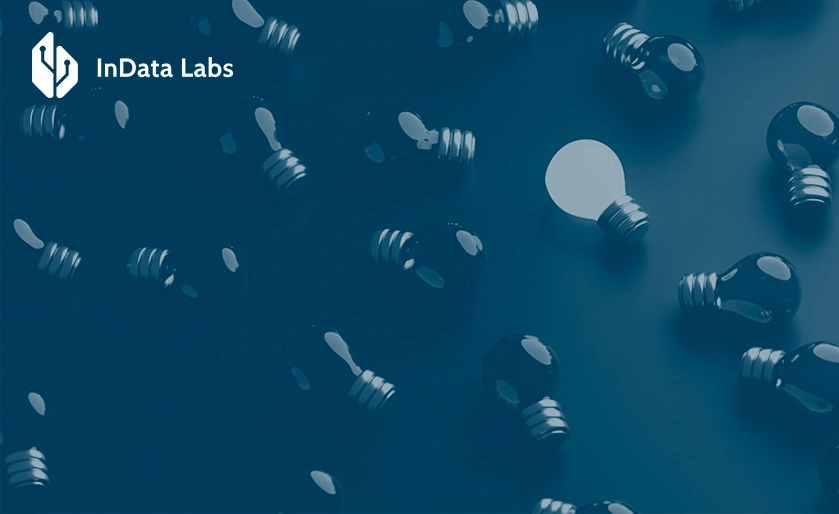In theory, data is an incredibly valuable asset for large and small businesses, but if they struggle to analyze their data for applicable insights, its true value remains untapped. Generative AI for data analytics can change this.
Generative artificial intelligence enables organizations to use data-derived insights to fine-tune their offerings, simplify operations, free employees to focus on key tasks, and improve customer experience.

Source: Unsplash
It’s not surprising, then, that the use of generative artificial intelligence increased by 38% from 33% in 2023 to 71% in 2024. This is expected to increase to more than 80% by 2026.
One of the reasons for the surge in adoption is that, unlike traditional predictive AI models, generative AI software replicates and understands the underlying data structure, yielding more accurate and relevant results. However, as with many technologies, the trick to using generative AI for data analytics effectively is knowing how to do it.
Data analytics challenges
Businesses often struggle to derive insights from data due to various challenges, with the result that making informed decisions becomes difficult, if not impossible. The main challenges include:
- Data silos: 68% of businesses are plagued by data silos, with data spread across various systems or departments. This makes it difficult to know where data is stored, how to access it, and how to analyze it across different functions.
- Data expert shortages: Some organizations struggle with data analytics as a result of AI, analytics, and data science skills shortages. That said, the US Bureau of Labor Statistics forecast that the data analyst job market will increase by 23% by 2032. It may seem contradictory to employ data specialists if businesses want to implement generative AI data analytics.

Source: Unsplash
However, there’s little chance of technologies such as ChatGPT replacing data analysts or other specialists anytime soon. AI can help data analysts, data scientists, and web developers do their work more efficiently, but it does not have the insights or knowledge that are essential for these roles.
- Complex, poor-quality data: The third main challenge facing businesses is a combination of poor data governance policies, even as data becomes more complex and the volume of data increases. The result is that they are left with untrustworthy, poor-quality data.
Benefits of using generative AI for data analytics
The challenges described above are not insurmountable. Businesses can overcome them and other challenges by using generative AI in data analytics, thanks to the benefits this offers. Some of the advantages experienced by businesses that embraced generative AI trends include:
- Enhanced analytics tool usability: Generative AI incorporates natural language interfaces rather than complex coding languages, allowing users to perform advanced tasks using basic English.
- Simplified initial data extraction stages: Combining generative AI and data analytics can simplify the initial stages of extracting, loading, organizing, and transforming data by using predictive algorithms and automatic schema recognition and normalization.
- Faster data preparation: Generative AI algorithms offer augmented data preparation. One of the ways they do this is by enriching data sets by predicting missing values and by sourcing and integrating external sources with high levels of consistency and accuracy due to advanced anomaly detection and pattern recognition.

Source: Unsplash
- Improved data analysis and automated analytics tasks: Predictive analytics become more accurate and thorough through the automated selection, validation, and tuning of machine learning models. Data analytics with generative AI eliminates many of the repetitive tasks involved, doing away with the need for time-consuming script coding.
- Better data visualization: Generative AI can create visual data insights and images, such as interactive dashboards, graphs, and charts, making complex information more accessible.
- Enhanced reporting: Generative AI integration into business offers enhanced reporting in the final stage of data analytics.GenAI’s natural language generation capabilities turn data into accessible, intelligible reports aimed at a wider audience.
How to use generative AI in data analytics
Knowing how to use generative AI in data analytics is the first step to taking full advantage of this technology and the possibilities it offers. The following suggestions highlight how organizations can apply it in every stage of the data analytics process.
Data collection
Data collection is the first step toward data analytics generative AI systems that yield relevant and valuable insights. Businesses can use their AI systems to automate data collection without web scraping or coding.
Additionally, they can train their AI systems using various types of data, such as web tracking or product analytics. For example, they can make sure their system has the input required for effective learning by using a virtual phone number for collecting data from different communication channels.
Data cleaning
Effective data analysis is impossible without clean data. If firms rely on manual data cleaning, they run the risk of using data that’s not as clean as they might think, as time-consuming manual processes can be impacted negatively by human error.
Firms can ensure the cleanliness of their data with the help of generative AI. For example, they can let their AI system take care of empty values, outlier identification, and data normalization.
Data analysis
The meat and bones of data analytics using generative AI become possible when businesses have collected relevant data, cleaned it, and used it to train their AI systems. After training, their systems can recognize anomalies, correlations, patterns, and trends and generate insights.
Unlike the manual processes involved in Big data analytics, which take days or weeks to complete, AI systems can complete the task within a few minutes. Having said this, it’s vital that businesses ensure that their data is unbiased, especially when the data is being used to train an AI system, as any biases in the data can affect system algorithms, resulting in biased outputs.
Using genAI in data analytics is relatively simple, as AI systems are conversational. If a business wanted to know how much money it made from a particular product, the relevant employee could ask the system a question such as, “How much revenue did [particular product] generate in June 2024?”
The system will then perform an analysis and generate a simple answer in plain English. If a more comprehensive answer is required, the question should be worded in a way that the system understands that it should produce a more detailed response. Watch this video to learn more about data analysis and how it can help you make smarter decisions.
Data visualization
Businesses that find noteworthy trends or patterns in their systems’ data analyses are likely to want to present those insights in an accessible format. This is where they can use visual tools like infographics, dashboards, interactive charts, and graphs for deeper data exploration and highlighting specific information using their genAI systems’ data visualization capabilities.
Businesses can use custom generative AI systems such as ChatGPT to automate basic data visualization tasks. Much like with the data analytics stage described above, inputting a simple prompt is enough to get an AI system to produce data visualizations.
Predictive analytics
Generative AI is a powerhouse when it comes to predictive analytics, such as sales targets based on past seasonal sales or inventory forecasts based on previous stock levels. Businesses can use their AI systems to run predictive models for accurate forecasts based on historical data patterns. Depending on the prompt, outputs can include detailed forecasts, summaries, and interactive data visualizations.

Source: Unsplash
Data-based decisions
GenAI data analytics culminate in making decisions based on accurate, clean, and relevant data. Businesses can use the insights provided by their AI systems to make informed decisions faster than they would if they had relied on traditional manual methods.
By creating strategies, adopting processes and tools, streamlining operations, and enhancing customer experience using the insights gained from this technology, companies with generative AI can expect a stronger competitive advantage.
Generative AI and data analytics: Considerations
As much as generative AI and data analytics offer significant benefits and possibilities to businesses, implementing this solution does come with a few risks. It’s vital that organizations are aware of these risks before using genAI for data collection, cleaning, and analysis. The most important considerations include:
- Accuracy: The accuracy of business data analytics and generative AI depends on the quality of the metadata and training data, with inaccurate data producing inaccurate results.
- Data security: If reliable safeguards are not in place, personal identifiable information and other sensitive data could be incorporated into a training dataset, compromising security and compliance.
- Unclear reasoning and inconsistencies: The machine learning models and neural networks used by genAI systems use an infinite number of permutations to produce results. This makes it difficult to explain the reasons behind their choices or recommendations. This is compounded by the fact that basic genAI models often generate different results from the same inputs and data, which is not ideal for use cases that require dependable, repeatable results.
- Rapid development: Generative AI development continues at a rapid pace, requiring organizations to ensure that their systems, frameworks, and tools are updated regularly.
GenAI in data analytics: Best practices
Businesses that wish to derive the greatest value from their use of data analytics with generative AI should implement the following best practices:
- Choose GenAI-compatible data analytics tools: Organizations should ensure that the data analytics tools they choose are compatible with GenAI systems. Tools intended for Big data analytics for business should be evaluated based on compatibility as well as their features, user interface, support services, scalability, versatility, and ease of use.
- Determine use cases, goals, and KPIs proactively: Businesses should determine particular genAI use cases in data analytics and establish goals and KPIs before implementing this solution. This supports team collaboration and task prioritization, as well as resource allocation, and the establishing of expectations. It also provides a framework for monitoring system performance and ensures that stakeholders and analysts share the same data objectives.
- Use good-quality data: It’s crucial that organizations implement a strong data governance framework to ensure data integrity and reduce the chances of biases creeping into their AI system algorithms. Data should be cleaned and preprocessed regularly, and it should be augmented through oversampling or creating synthetic data to enhance the quality and amount of training data.Additionally, it should be enriched by collecting data from various sources such as AI chatbots, IoT devices, third parties, social media, and internet databases.
- Update and monitor GenAI systems: Organizations should regularly monitor and update the systems they use for generative AI data analytics. This should include retraining the LLM for analytics with new data, parameter adjustments, and the implementation of automated monitoring.

Source: Unsplash
- Encourage stakeholder-data scientist collaboration: Businesses should encourage stakeholders and data scientists to collaborate with each other. This will ensure that their genAI data analytics strategies are in harmony with business objectives.
Generative AI use cases in data analytics
The generative AI uses cases in data analytics are incredibly broad. A few notable examples of generative AI applications include:
Product recommendations: Retailers can use customer browsing habits and purchase history to train generative AI systems to provide personalized product recommendations for increased conversion rates and customer satisfaction.
Natural language processing: The ability of generative AI models to understand and generate human-like text allows them to be used for content generation and translation, as well as AI chatbot development to enhance customer experience.
Predictive analytics: Businesses can use genAI to analyze substantial datasets for accurate predictions regarding stock prices, customer churn rate, and other topics.
Automated data governance: By integrating genAI systems into data governance tooling, organizations can automate and improve tasks such as data documentation, lineage tracking, and metadata generation.
Fraud detection: Synthetic data representing risk scenarios and fraudulent activities allows businesses to train their generative AI systems, improving their fraud detection algorithms and reducing false positives.
Geospatial analytics: Insurance providers can use generative AI systems’ geospatial analytics capabilities to collect structured data from high-resolution imagery for property construction, condition, and size insights that assist with property risk assessment and claim management.
Data set creation: Organizations in industries where customer or patient data is regulated heavily can use genAI to create synthetic training data for accelerating product or service development and deployment, building proof of concepts, and avoiding the violation of privacy laws.
Harness the power of generative AI data analytics
Generative AI is transforming the realm of data analytics by enabling businesses to extract deeper, more actionable insights from their data faster than ever before.
By enhancing data accuracy and cleanliness, simplifying processes, and enabling predictive and visual outputs, artificial intelligence business solutions lead organizations from complex analytics to practical decision-making. However, genAI data analytics should be implemented carefully, with organizations ensuring they use high-quality data, responsible data governance, and regular updates while encouraging cross-team collaboration.



